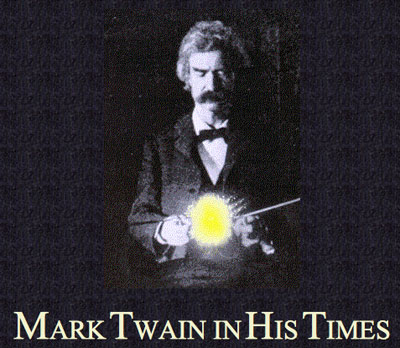talking history | syllabi | students | teachers | puzzle | about us
Mark Twain in His Times
http://etext.lib.virginia.edu/railton/index2.html
Written and directed by Stephen Railton; produced by the Electronic Text Center, University of Virginia.
Reviewed Dec. 25, 2000-Jan. 5, 2001.
This splendid site, as Professor Stephen Railton explains, is a permanent electronic archive of writings by and about Mark Twain and an evolving virtual exhibition, featuring the extraordinary Twain holdings of the University of Virginia’s Barrett Library of American Literature and drawing on the resources of Virginia’s Electronic Text Center. It is also a superb teaching resource for instructors from high school to the graduate level, with a link to the Web pages of Railton’s own Twain seminar.
As an exhibition, Mark Twain in His Times explores how both the cultural celebrity Mark Twain, the most famous pen name in American letters, and his works were simultaneously “created and defined, marketed and performed, reviewed and appreciated.” The first three of its nine sections focus on aspects of Samuel Clemens’s professional life: the evolution of the image of Mark Twain, as shaped both by Clemens himself and by contemporary observers; the elaborate ways in which his books were marketed, including one of the most fully documented accounts of the practice of subscription sales in the late nineteenth century; and Clemens’s lengthy lecture career performing Mark Twain, complete with advertisements and sound file re-creations of his platform style. The remaining sections focus on six important books—Innocents Abroad (1869), Roughing It (1872), Tom Sawyer (1876), Huckleberry Finn (1884), Connecticut Yankee (1889), and Pudd’nhead Wilson (1894)—though fully three dozen Twain works are available in searchable e-texts. Here again much attention is paid to merchandising, though there is always a wealth of material on the book itself, including sources and variations, illustrations and related texts, and its critical reception as expressed in contemporary newspaper and magazine articles. A lengthy bibliography is a click away, and many kinds of searches are possible.
Special features abound. The Innocents Abroad section, for example, offers a map of the actual journey on which it is based that enables the reader to approach the book in spatial terms, which illuminates, as Railton explains, the “geo-cultural” prejudices of its period. The Huck Finn section traces cultural attitudes toward race through a history of illustrations of Jim, while the Connecticut Yankee pages examine America’s conflicted obsession with both the Middle Ages and anti-Catholicism, as well as Clemens’s financially ruinous fascination with new technology (he would have loved this site but lost his shirt in the Nasdaq market). Railton everywhere provides brief, useful, and thoughtful description and analysis, informed by his vast knowledge. He writes in the first person, so that the browser always feels in the presence of a wise and trusted individual guide.
Railton, the author of an equally wonderful Web project on Uncle Tom’s Cabin, states that the site’s numerous interactive features (including a Twain-inspired “Memory Game” that helps develop a factual knowledge of the author’s career and era) and visual riches are intended to appeal to students accustomed to Web culture and as such are part of an attempt to "re-present" its subject. But it is its old-fashioned intellectual rigor and attention to detail, quality of content, and ease of navigation that make this site so engaging and rewarding.
Carl Smith
Northwestern University
Evanston, Illinois

